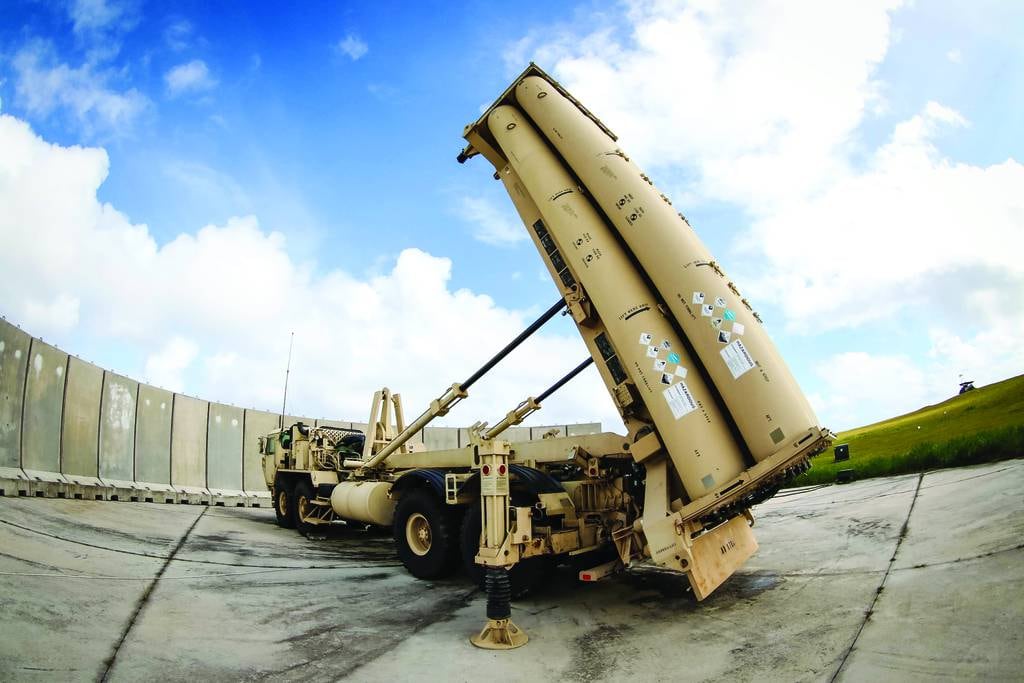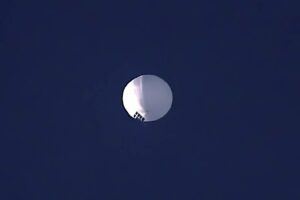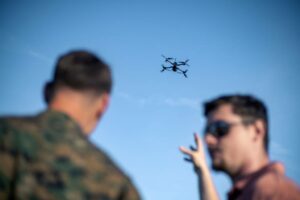
WASHINGTON — Pentagon leaders who consider China a growing threat say 2024 will be a key year for the Army to bolster defenses around Guam, one of the most critically strategic islands in the Indo-Pacific region.
During that year, the service plans to have in place a foundational capability to help stave off a potential attack.
The Missile Defense Agency and the Army are seeking a combined $1.5 billion in the fiscal 2024 budget to begin preparing the island by moving assets into place and integrating capabilities. The effort is a test for the Army, which decision-makers have at times overlooked amid the focus on air and naval power in the Indo-Pacific region.
The Pentagon designated the Army earlier this year as the lead service overseeing the acquisition and execution plan for defending Guam. Success there could help cement the Army’s air and missile defense role in the region, but experts say the timeline may prove too ambitious.
Mark Montgomery, a defense expert at the Foundation for Defense of Democracies, said the Army sought the lead role when the other services were more reluctant. However, the service may struggle to deliver as promised.
“We’re talking about something that needs to be delivered fairly rapidly by a program executive that is not known for delivering fairly rapidly,” Montgomery said.
Due in 2024
Guam, an island of nearly 170,000 people, sits in a vulnerable position, according to Brad Bowman, a national security analyst also at FDD.
“There’s a real threat to Guam, not just because [China has] some vendetta against the island but because there’s a lot of U.S. combat power there that would flow toward China in the case of a war in the Taiwan Strait,” he told Defense News. “Guam would be a vital place through which additional U.S. forces coming from the United States, from Hawaii and elsewhere would be flowing and would play an important sustainment and logistics role.”
The U.S. is trying to address that concern. Earlier this year, then-Missile Defense Agency Director Vice Adm. Jon Hill said the first wave of defenses will include radars, launchers, interceptors, and a command-and-control system.
All are slated to arrive on the island in 2024, according to Hill, who has since retired.
The Army requested $638 million for FY24 for three Lower Tier Air and Missile Defense Sensors, multiple Patriot air defense systems, and an assortment of Mid-Range Capability missile launchers and Indirect Fire Protection Capability launchers. Additionally, the service plans to use the Northrop Grumman-made Integrated Battle Command System to connect the right sensors to the right shooters on the battlefield.
The Navy will provide technology and capability from its Aegis weapon system; the service holds jurisdiction over the sites where it will place the technology.
Additionally, FY24 funding requests are meant to cover the installation along the island’s periphery of four high-end, solid-state, mobile AN/TPY-6 radars, which are new sensors that use technology from the Long Range Discrimination Radar in Clear Space Force Base, Alaska.
The Army is still working on a detailed strategy on how to build the architecture on Guam, Brig. Gen. Frank Lozano, program executive officer for missiles and space, told Defense News in late September, following a planning session on the island.
At the end of FY24, the Missile Defense Agency plans to conduct the first live-fire test of the Guam defense system with the initial capability established on the island, Rear Adm. Doug Williams, who is serving as the acting director, said in August.
Hurdles ahead
But experts warn the Army and MDA face a range of challenges, from relying on technology in prototype form to finding the right areas for equipment to integrating all systems.
Montgomery noted one of the earliest proposals for the architecture was to set up an Aegis Ashore system on the island, but the military wanted a more distributed system. Now the plan is to host radars on four or five fixed sites on the island and design them to be mobile, much like miniature Aegis Ashore systems. But moving a radar could take weeks.
This latest approach will be “a scientifically, technologically challenging event,” Montgomery said.
Additionally, Montgomery added, the new AN/TPY-6 radar, meant to detect complex hypersonic and cruise missile threats, may not be ready for tests in 2024.
The Pentagon opted to use technology from the existing Long Range Discrimination Radar in Alaska, but break it up into multiple panels to make the AN/TPY-6 radars, Laura DeSimone, MDA executive director, told Defense News in August. To achieve 360-degree coverage of the entire island, the agency needed to move away from single- or dual-face large structure antenna arrays.
Now, the Defense Department plans to put one of the early panels on the island “to do some integration with potentially one of the launchers and then knit it into a localized, little command-and-control node,” DeSimone said.
When it comes to launchers, the military expects to use vertical launching systems like those with the Mid-Range Capability missile the Army fielded to its first unit this year.
Congress has approved funding to start buying the capability for Guam, but the tech isn’t expected to arrive until late 2024 or early 2025. As a result, the Army and MDA might need to use a different launcher on a temporary basis for testing in 2024, Montgomery said.
Other elements for the Guam architecture still in prototyping phases include the Indirect Fire Protection Capability, a system that would provide cruise missile defense. This program is delayed and now involves a compressed test schedule as a result.
The Lower Tier Air and Missile Defense Sensor — another radar capable of detecting air and missile defense threats from 360 degrees — is also delayed and entered operational testing in November for a limited capability.
As a result of prototype delays, the Army should consider delivering a fielded system like the National Advanced Surface-to-Air Missile System used to defend the National Capital Region, Montgomery said, noting this might be a simple, less expensive and temporary solution.
Patriot air defense systems are also capable of defeating cruise missiles, but the Patriot force is among the highest in demand around the globe, and some are newly obligated to the Middle East to protect the U.S. and its allies amid the Israel-Hamas war. Additionally, each Patriot missile costs about $3 million.
Tom Karako, a missile defense analyst at the Center for Strategic and International Studies think tank, said integration also poses a key challenge.
“The 360-degree air and missile defense requirements for Guam will force the missile defense community to get down to brass tacks about what exactly integration really means and what it will require,” he said.
Once the Army comes up with its strategy for systems integration, then “site work, infrastructure development and testing can get underway in earnest,” Karako said. “The more time ticks by, the closer the Chinese cruise missiles get.”
Jen Judson is an award-winning journalist covering land warfare for Defense News. She has also worked for Politico and Inside Defense. She holds a Master of Science degree in journalism from Boston University and a Bachelor of Arts degree from Kenyon College.
- SEO Powered Content & PR Distribution. Get Amplified Today.
- PlatoData.Network Vertical Generative Ai. Empower Yourself. Access Here.
- PlatoAiStream. Web3 Intelligence. Knowledge Amplified. Access Here.
- PlatoESG. Carbon, CleanTech, Energy, Environment, Solar, Waste Management. Access Here.
- PlatoHealth. Biotech and Clinical Trials Intelligence. Access Here.
- Source: https://www.defensenews.com/outlook/2023/12/04/us-faces-hurdles-next-year-for-guams-missile-defense-experts-warn/
- :has
- :is
- :not
- :where
- $3
- $UP
- 000
- 2020
- 2024
- 2025
- 27
- 360
- 360-degree
- 70
- 8
- a
- About
- According
- Achieve
- acquisition
- acting
- added
- Additional
- Additionally
- address
- advanced
- against
- agency
- AIR
- aircraft
- alaska
- All
- along
- also
- Amid
- among
- an
- analyst
- and
- Another
- antenna
- approach
- approved
- April
- architecture
- ARE
- areas
- Army
- around
- Arts
- AS
- Assets
- assortment
- At
- attack
- AUGUST
- award-winning
- away
- base
- basis
- Battle
- Battlefield
- BE
- because
- begin
- Billion
- boston
- Boston University
- brad
- brass
- Break
- budget
- build
- but
- Buying
- by
- CAN
- Can Get
- capabilities
- capability
- capable
- capital
- case
- cement
- Center
- challenge
- challenges
- challenging
- China
- chinese
- clear
- closer
- College
- combat
- combined
- comes
- coming
- community
- complex
- Concern
- Conduct
- Connect
- Consider
- Costs
- could
- cover
- coverage
- covering
- cruise
- decision-makers
- defeating
- Defending
- Defense
- Defense Department
- Degree
- Delayed
- delays
- deliver
- delivered
- delivering
- Demand
- Department
- Design
- designated
- detailed
- detect
- Development
- different
- Director
- Discrimination
- distributed
- do
- doug
- down
- each
- Earlier
- earliest
- Early
- East
- effort
- elements
- elsewhere
- end
- entered
- Entire
- equipment
- established
- Event
- exactly
- execution
- executive
- Executive Director
- Executive Officer
- existing
- expected
- expects
- expensive
- expert
- experts
- Face
- faces
- fairly
- finding
- Fire
- First
- Fiscal
- five
- fixed
- flow
- Flowing
- Focus
- following
- For
- Force
- Forces
- form
- Foundation
- Foundational
- four
- frank
- from
- funding
- Gen
- get
- globe
- Growing
- harbor
- Have
- hawaii
- he
- help
- High-End
- highest
- holds
- host
- How
- How To
- However
- HTTPS
- Hurdles
- images
- important
- in
- include
- Infrastructure
- initial
- inside
- installation
- integrated
- Integrating
- integration
- International
- into
- involves
- island
- Islands
- IT
- ITS
- jon
- journalism
- journalist
- jpg
- jurisdiction
- just
- Key
- knit
- known
- Land
- large
- Late
- latest
- launching
- lead
- leaders
- less
- like
- Limited
- little
- logistics
- Long
- Lot
- lower
- make
- master
- May..
- means
- meant
- Middle
- Middle East
- might
- Military
- million
- missiles
- Mobile
- more
- most
- move
- moving
- much
- multiple
- National
- national security
- nearly
- Need
- needed
- needs
- New
- newly
- news
- next
- node
- noted
- noting
- November
- now
- of
- off
- Officer
- on
- ONE
- operational
- or
- Other
- over
- overseeing
- panels
- pentagon
- People
- Place
- plan
- planning
- plans
- plato
- Plato Data Intelligence
- PlatoData
- Play
- poses
- position
- potential
- potentially
- power
- preparing
- Program
- promised
- Proposals
- protect
- protection
- prototype
- prototyping
- Prove
- provide
- put
- radar
- range
- rapidly
- ready
- real
- really
- region
- relying
- requested
- requests
- require
- Requirements
- result
- right
- Role
- s
- Said
- say
- Science
- security
- seeking
- sensor
- sensors
- September
- service
- Services
- serving
- session
- set
- she
- should
- Simple
- since
- Sites
- sits
- solution
- some
- something
- sought
- Space
- Space Force
- start
- States
- Still
- Strategic
- Strategy
- structure
- Struggle
- studies
- success
- system
- Systems
- Taiwan
- Take
- talking
- tank
- tech
- Technology
- temporary
- test
- Testing
- tests
- that
- The
- Them
- then
- There.
- think
- think tank
- this
- this year
- those
- threat
- threats
- three
- Through
- tier
- time
- timeline
- times
- to
- told
- Tony
- too
- toward
- trying
- u.s.
- U.S. Navy
- Underway
- unit
- United
- United States
- university
- until
- us
- use
- used
- vertical
- via
- vice
- vital
- Vulnerable
- wanted
- war
- was
- Wave
- Weeks
- were
- What
- when
- which
- WHO
- will
- Williams
- with
- Work
- worked
- working
- would
- year
- zephyrnet












